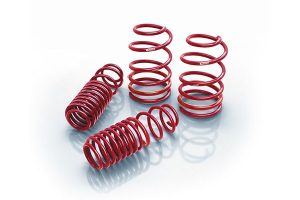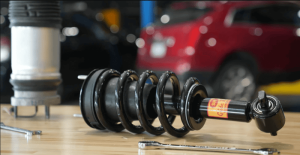Suspension springs play a critical role in ensuring a vehicle’s comfort, handling, and safety. Among the many types of suspension springs available today, two dominate most aftermarket and OEM applications: progressive and linear (also called constant-rate) springs. Whether you’re upgrading your car’s suspension or simply trying to understand the technology under your vehicle, choosing between progressive and linear springs is crucial.
This article breaks down the structural and functional differences between the two, the pros and cons of each, and which type best suits various driving styles and vehicle types.
What Are Suspension Springs?
Suspension springs absorb shocks from road irregularities and support the vehicle’s weight. They help maintain tire contact with the road, impacting steering, braking, and ride comfort. The spring rate — how stiff a spring is — defines how much a spring compresses under load and plays a major role in tuning a suspension system.
There are two common types based on their spring rate behavior:
| Type | Spring Rate Behavior |
|---|---|
| Linear | Constant spring rate throughout compression |
| Progressive | Variable spring rate — gets stiffer with compression |
Linear Springs: Simplicity and Predictability

Linear springs have a constant spring rate throughout their entire range of motion. That means for every unit of force applied, the spring compresses by the same amount.
Pros of Linear Springs:
-
Predictable handling: Ideal for motorsports and performance driving
-
Consistent response: Easier to tune with dampers
-
Durability: Less prone to fatigue due to uniform stress distribution
-
Easier maintenance: Less complex suspension tuning
Cons of Linear Springs:
-
Less comfortable ride: Firmness is constant, which can transmit more road noise and harshness
-
Not ideal for varying loads: Performance may suffer with changing cargo or passenger weight
Progressive Springs: Comfort Meets Adaptability
Progressive springs feature coils that are spaced variably, resulting in a spring rate that increases as the spring compresses. Light loads compress the softer section; heavier loads engage stiffer coils.
Pros of Progressive Springs:
-
Better ride comfort: Absorbs small bumps with soft initial compression
-
Improved load adaptability: Handles different weights without sagging
-
Great for daily use: Offers a balance between comfort and control
Cons of Progressive Springs:
-
Less predictable performance: Can be harder to tune, especially for track use
-
More expensive: Design complexity leads to a higher cost
-
Inconsistent damping match: Not all shock absorbers pair well with progressive springs
Progressive vs. Linear Springs: Comparison Table
| Feature | Linear Springs | Progressive Springs |
|---|---|---|
| Spring Rate | Constant | Variable |
| Comfort | Medium to low | High at low compression, firmer under load |
| Performance Handling | Excellent | Good, but less predictable |
| Tuning Ease | Easier | More complex |
| Price | Generally cheaper | Generally more expensive |
| Use Case | Track, motorsport, consistent loads | Daily driving, mixed loads, comfort-based |
When to Choose Linear Springs
Choose linear springs if:
-
You drive a sports car or track vehicle
-
You require precise handling and feedback
-
Your vehicle carries consistent loads
-
You plan to custom tune your suspension setup
These springs shine in performance environments where predictability and stability are crucial — such as racing, autocross, or spirited driving.
When to Choose Progressive Springs
Choose progressive springs if:
-
You want comfort for daily commuting
-
Your vehicle sees varying passenger or cargo loads
-
You own an SUV, crossover, or family car
-
You drive on uneven or rough roads frequently
Progressive springs offer the best of both worlds for everyday use, making them ideal for drivers who value comfort but occasionally need stiffer support.
Application Scenarios
| Vehicle Type | Recommended Spring Type | Reason |
|---|---|---|
| Sports Car | Linear | Maximum handling control |
| Family Sedan | Progressive | Comfort for varying loads |
| Off-road SUV | Progressive | Flexibility for terrain changes |
| Track Car | Linear | Precision and performance |
| Daily Driver | Progressive | Balanced comfort and stiffness |
Installation Considerations
No matter which type you choose, professional installation and compatible dampers (shock absorbers) are essential. Installing progressive springs with mismatched shocks can lead to poor performance or premature wear. Always check whether your shocks are designed to accommodate variable spring rates.
Tips for Spring Maintenance:
-
Inspect regularly for cracks, rust, or sagging
-
Replace in pairs (front or rear) to maintain balance
-
Avoid exceeding load limits to prevent premature wear
-
Re-align suspension after replacing springs to ensure proper geometry
Conclusion: Which Should You Choose?

The best spring type depends on your driving needs:
-
Choose linear springs for control, performance, and a consistent response — ideal for the enthusiast or racer.
-
Choose progressive springs for comfort, versatility, and a better ride — perfect for daily drivers, family cars, and occasional off-roaders.
Before making your decision, evaluate your driving habits, load needs, and vehicle type. The right springs can drastically improve your vehicle’s handling, comfort, and longevity.
Buy Springs & Components online — Explore a wide range of linear and progressive springs tailored to your vehicle. Whether you’re upgrading your suspension or replacing worn components, find high-quality parts to match your ride’s needs.